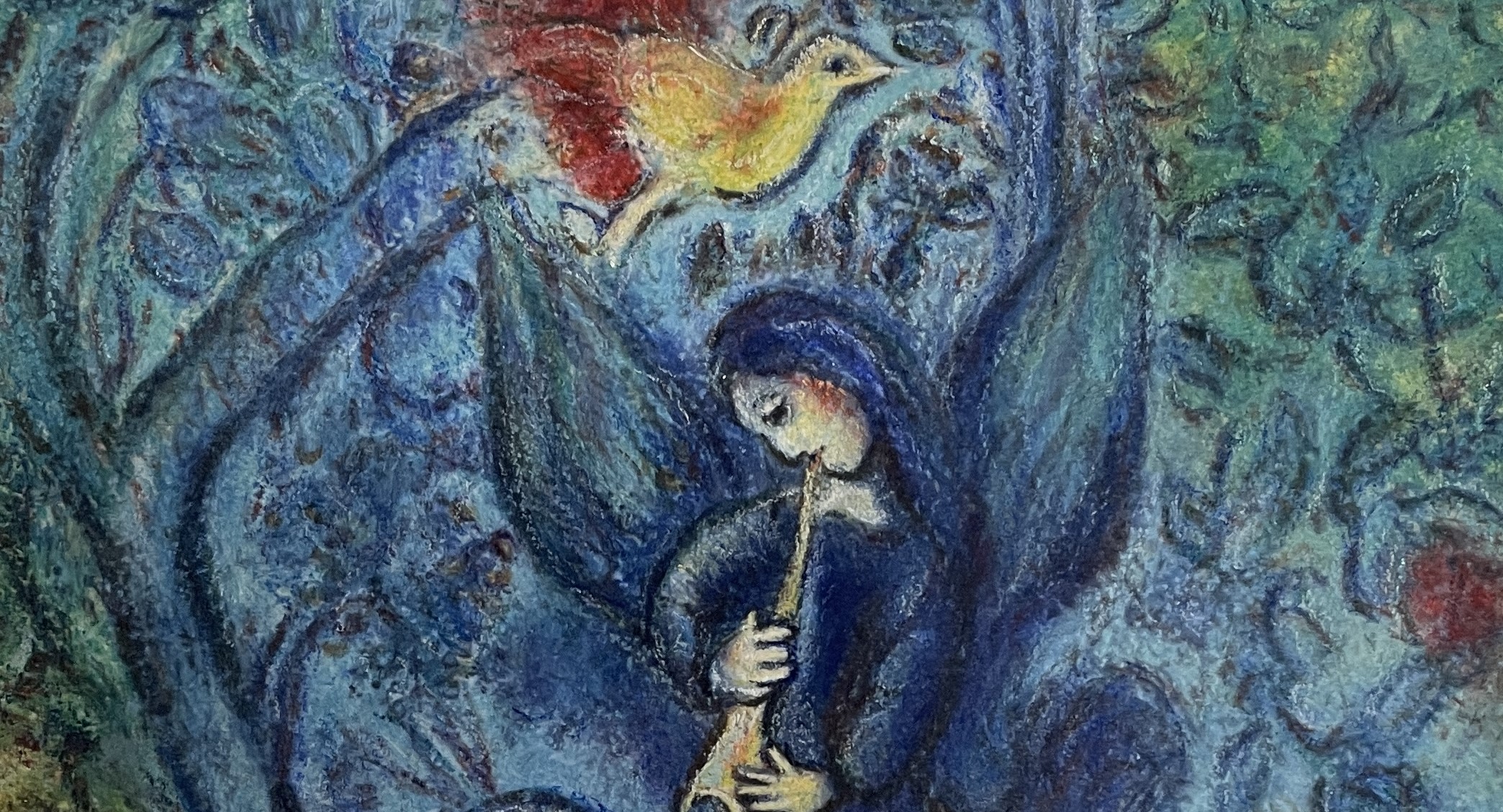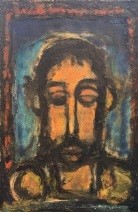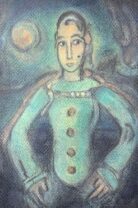日本語-Englishー台灣華語
ジョルジュ・ルオー「キリストの肖像」
家具職人の子として生まれたルオーは、ステンドグラス職人となり、そして画家となった。ルオーの絵はとても真似のできない絵だとずっと思っていたが、やってみると案外そうではない。薄塗りでも意外にルオーの雰囲気が出る。そういえばルオーの版画でさえ、どこか油絵の雰囲気を感じさせる。厚塗りだけがルオーの特色と言う訳ではなさそうだ。ルオーの絵は多少線や色が違っていても、概ねルオーらしき絵に留まってくれる。黒い線は思いきって描くに限る。ケチって描くとルオーらしくない。ルオーの絵は心に堆積した鬱憤をまるで晴らしているかのようだ。
ルオーの絵を模写してみると、それは決して罪の告白や宗教的な絵ではないように思えてくる。 ルオーの絵には画家の人間性がとりわけ色濃く反映している。ルオーは言っている。「私は一生を通じて金の心配をしていた。未来への、貧乏への、不安があった。長い間みんなに見離なされ、どうしたら生きていけるのだろう」と。それでも絵を描くことしかできない自分がピエロのように思えたに違いない。見渡せばこの世には無数の名もなく貧しい人々が、その務めを黙々と果たして死んで行く。彼らにこそ人生の真実があるのではないか。だから娼婦であっても、ルオーの作品の中では聖人やキリストと同じ地位を占めている。ルオーは悪を、腐敗を、いかがわしい快楽を描きながら、人生の奥義を探ろうとする。黙々と塗り込められた絵の具は次第に強さを増し、ルオーの苦悩はいつしか美に転化する。ルオーは師モローと同様に、どこか社会と巧く折り合いをつけられずに、社会に対する幻滅を、美の世界に身を置くことでかろうじて繋ぎ止めている危うさがある。危うさは美の秘薬なのかもしれない。
ルオーの絵の良さはすぐにはわからない。傍らに置いてこそ、その魅力を感じることができるのかもしれない。そういえば松涛美術館で開催されていた小林秀雄が愛蔵していた美術品の展覧会にルオーがあった。小林秀雄の高尚で難しいエッセイにはかつて大学入試の時に散々苦しめられたが、元ネタの絵がこれかとがっかりした。小林秀雄に本当の審美眼があったのか少し疑わしく思われたが、作家の財力で買える作品には限りがあるということか。ルオーの絵を手元に置いて文章を書こうとするその姿勢が立派であると言うべきか。ブリジストン美術館(現アーティゾン美術館)や出光美術館にあるルオーこそが小林秀雄の文章にふさわしい。
ルオーの絵を描いていると絵の完成と未完成の境界について考えさせられる。ルオーはかつて画商に預けてあった絵を、未完成であるとして裁判までして取り返し、廃棄と加筆を繰り返したと言うが、絵はいつをもって完成とするかはとても難しい問題だ。筆を置くことは一つの決断である。ボナールは美術館に納められた絵にも加筆していたというが、セザンヌが恐れるように、確かに一筆を加えたことによって全ての画面が崩れることがしばしば起こる。もう一筆加えることによる崩壊に怯えながら、一歩でも深く進もうとするのもまた画家なのである。むしろルオーのように絵に完成はないと悟り、永遠に筆を加え続けると決める方法もあるのだと私は気づかされる。
その一方でピカソは筆を置くべき時期を知っていた。オルガの肖像などは一見未完成に見えるが、これ以上描き進めることができないところで筆が置かれている。どちらをもって才能のある画家と呼ぶべきか、私はにわかには決めることができない。
Passion
Born as the son of a furniture craftsman, Rouault became a stained glass artisan, and then a painter. I always thought Rouault’s paintings were inimitable, but trying to replicate them, I found they were not so difficult after all. Even with thin layers, one can surprisingly capture Rouault’s ambiance. Indeed, even Rouault’s prints somehow convey the atmosphere of his oil paintings. It seems that thick layers are not the only characteristic of Rouault’s style. His paintings remain distinctly Rouault-like, even if the lines or colors slightly differ. Bold black lines are essential; drawing them timidly does not capture his essence. Replicating Rouault’s paintings feels like venting accumulated frustrations, as if they are not confessions of sin or religious paintings.
Rouault’s paintings intensely reflect the artist’s humanity. Rouault said, “Throughout my life, I worried about money. I had fears about the future, about poverty. I felt abandoned by everyone for a long time, wondering how I would survive.” Yet, he must have felt like a clown, only able to paint. Looking around, countless nameless and poor people silently fulfill their duties and die. Perhaps the truth of life belongs to them. Thus, in Rouault’s works, prostitutes occupy the same status as saints and Christ. While depicting evil, corruption, and dubious pleasures, Rouault seeks the mysteries of life. The diligently applied paint gradually intensifies in strength, transforming Rouault’s anguish into beauty. Like his mentor Moreau, Rouault struggled to reconcile with society, barely clinging to the world of beauty amidst disillusionment with society. This precariousness may be the elixir of beauty.
The allure of Rouault’s paintings is not immediately apparent. Their charm may only be felt by keeping them close by. Remembering the art exhibition of Hideo Kobayashi’s cherished art pieces at the Shoto Museum of Art, including Rouault, I was disappointed to realize this was the original source of Kobayashi’s sophisticated and challenging essays that once tormented me during university entrance exams. Doubts arose about Kobayashi’s true aesthetic sense, considering the limited range of artworks a writer could afford. Perhaps the attitude of writing with a Rouault painting at hand is commendable. The Rouault in the Bridgestone Museum of Art or the Idemitsu Museum of Arts are indeed worthy of Kobayashi’s writings.
Painting Rouault’s works prompts contemplation on the boundary between completion and incompletion. Rouault once retrieved paintings from a dealer, claiming they were unfinished, and repeatedly discarded and added to them, highlighting the difficult question of when a painting is considered complete. Putting down the brush is a decision. Bonnard was known to add to paintings even after they were placed in museums, and as Cézanne feared, indeed, adding just one stroke often leads to the collapse of the entire composition. The fear of collapse by adding another stroke, yet striving to delve deeper, is also the essence of being a painter. Realizing that, like Rouault, there is no completion to a painting, and deciding to eternally add to it, is another method I’ve become aware of. Meanwhile, Picasso knew when to put down the brush. Portraits like Olga’s seem unfinished immediately, but the brush was laid down where no further progress could be made. Deciding which approach denotes a talented artist is something I cannot hastily determine.
喬治·魯歐《基督肖像》
喬治·魯歐出生於一個家具匠人的家庭,後成為了一位玻璃彩繪工和畫家。長久以來,我一直認為魯歐的畫作是無法模仿的,但實際上嘗試後發現並非如此。即使是薄塗,也意外地能呈現出魯歐的氛圍。說起來,即便是魯歐的版畫,也能感受到某種油畫的氣息。看來,厚塗並不是魯歐特色的唯一。魯歐的畫作即使線條或顏色略有不同,總體上還是能保持著魯歐的風格。黑色的線條,大膽地畫最好。若畫得吝嗇,就不像魯歐的風格了。魯歐的畫作仿佛能清除心中積累的悶氣。模仿魯歐的畫作,你會發現它們並不像是罪的告白或宗教畫。
魯歐的畫作深刻反映了畫家的人性。魯歐說過:“我一生都在擔心金錢問題,對未來、貧窮和不安感到擔憂。長時間被人遺棄,不知如何是好。”即使如此,他也只能畫畫,肯定覺得自己像個小丑。看來,這世上無數無名且貧窮的人默默履行他們的職責直至死去。或許他們的生活中才有真正的真理。因此,在魯歐的作品中,妓女也能擁有與聖人或基督相同的地位。魯歐在描繪邪惡、腐敗和可疑的快樂的同時,試圖探索生命的奧秘。默默地塗抹的顏料逐漸增強其力量,魯歐的痛苦最終轉化為美。魯歐與他的老師莫羅一樣,似乎都無法與社會和諧相處,對社會感到幻滅,幾乎是靠著置身於美的世界中來維持著脆弱的平衡。這種危險或許就是美的秘藥。
魯歐的畫作的美好不是立刻就能理解的。也許只有放在身邊,才能真正感受到它的魅力。記得在松濤美術館舉辦的小林秀雄珍藏藝術品展覽會中,就有魯歐的作品。我曾經在大學入學考試時被小林秀雄那高深莫測的文章所苦,但當我發現原作就是這些時,感到有些失望。我開始懷疑小林秀雄是否真的有真正的審美眼,或許是因為作家的財力有限。或許應該讚賞他嘗試將魯歐的畫作放在手邊來寫作的態度。位於橋石美術館和出光美術館的魯歐作品,或許更配得上小林秀雄的文字。
當畫魯歐的畫時,會讓人思考完成與未完成之間的界限。魯歐曾經因為認為交給畫商的畫作未完成而發起訴訟,並對其進行廢棄和加筆,確定何時算是完成是一個難題。放下畫筆是一種決定。就像波納爾曾在美術館的畫作上加筆一樣,如同塞尚所擔憂的,確實,一筆之差可能會讓整個畫面崩潰。畫家常常在恐懼崩潰的邊緣,試圖更深入地前進。或許像魯歐那樣認為畫作永遠無法完成,決定不斷加筆也是一種方式。另一方面,畢加索知道何時該停筆。例如奧爾加的肖像,看似未完成,但實際上是因為再也無法進一步描繪而停筆。我無法立刻決定哪種是有才華的畫家。



